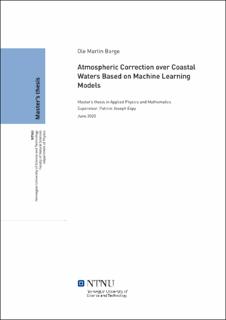| dc.description.abstract | Atmospheric correction (AC) is often the first step in ocean-color remote sensing algorithms for satellites and would ideally remove atmospheric and ocean surface radiances to produce water-specific properties like the water-leaving radiance ($L_w$) or remote sensing reflectance ($R_{rs})$. These properties can again be used to derive ocean color products, such as the essential climate variable chlorophyll concentration (CHL), used to study phytoplankton changes in the ocean ecosystems to understand ecosystem responses to climate changes. AC in ocean color is critical as the atmosphere may contribute as much as \SI{90}{\percent} of the measured top of the atmosphere (TOA) radiance in the blue wavelength regions over clear waters, and even higher in coastal areas. Standard AC algorithms work well for open oceans, but not for turbid coastal waters, where empirical assumptions done by the algorithms tend to fail.
In this master study, new AC and Inherent Optical Properties (IOP) retrieval algorithms for hyperspectral imaging over coastal waters based on the Machine Learning (ML) models Neural Network (NN), Partial Least Squares Regression (PLSR), Support Vector Regression (SVR) and Stochastic Gradient Descent Regression (SGDR) were tested. The different models were validated against each other with different metrics: the Pearson correlation coefficient (R), the mean percentage bias (Bias), the average percentage difference (APD), the root mean squared difference (RMSD) and the normalized RMSD (NRMSD), and were compared to determine the ML approach best suited for on-board processing. For this study, the coupled atmosphere-ocean Radiative Transfer Model AccuRT was used to simulate the interaction of solar radiation with particles and molecules in the atmosphere and ocean. Hyperspectral TOA radiance was generated based on various inputs of sensor geometries, AOD(869), and global in-field measurements of water IOPs from the NOMAD and CCRR datasets. The simulated data were used as training and validation data for the different ML models, where the goal was to predict $R_{rs}$.
When predicting $R_{rs}$ from TOA radiance corrected for Rayleigh and absorption ($L_{rac}$), all ML models resulted in $\mathrm{R}^2$ > 0.968, indicating that they were able to predict the spectral relationship between $L_{rac}$ and $R_{rs}$. The best results were obtained with the NN algorithm ($\mathrm{R}^2$=0.999), especially compared to the linear models PLSR ($\mathrm{R}^2$=0.974) and SGDR ($\mathrm{R}^2$=0.968). On the other hand, the linear models provided interpretable coefficients.
Also, unlike many standard AC algorithms, these models were capable of doing AC without the extra short-wave infrared (SWIR) bands, as they were trained on hyperspectral data in the wavelength region \SI{400}{}-\SI{800}{\nano \meter}. Finally, the NN approach could also be used for water IOP retrieval, and provided $\mathrm{R}^2$ > 0.9998 when predicting chlorophyll concentration from $R_{rs}$. In further work, the ML models should be tested on $in$ $situ$ data and be validated against standard AC algorithms.
The different AC algorithms based on ML became very fast once they had been trained and would therefore suit operational use in satellites and be part of the on-board data processing framework. | |
